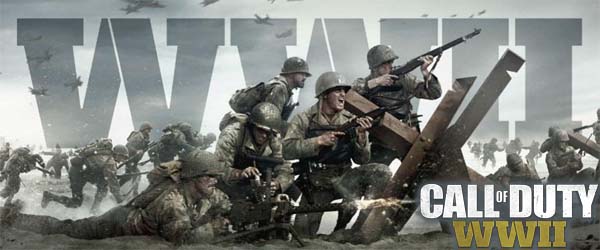
I haven't played a Call of Duty game since World At War on the PS3 almost 10 years ago. I really liked the first two CoD games on PC, but after Infinity Ward stopped developing the games, they increasingly focused on spectacle rather than any attempt to accurately portray war. After throwing back more enemy grenades in the first mission of World At War than were probably ever manufactured in all of World War II (I'm exaggerating a little bit), I got sick of that game and basically gave up on the franchise.
After having a little bit of fun with EA's Battlefield 1, I decided to pick up a used copy of Call of Duty World War II from eBay. I was curious if the return to World War II would be taken a little bit more seriously by Activision. It wasn't. This is the same old stale Call of Duty that I've been actively avoiding for the past decade. The single-player campaign didn't do anything to pull me in.
A light-gun shooting gallery
Probably the biggest problem with the campaign is just how rote and repetitive it feels. Almost all of the game's missions boil down to moving from one shooting gallery to another. When you aren't in an outright combat tunnel (like a bunker or trench), you're only given about a hundred feet of lateral space to work with. The whole game feels very confined and small in scale, with very few opportunities for any tactical movement such as flanking maneuvers. Just sit behind cover and pop out to take a few shots, then repeat. It might as well be an on-rails shooter, or one of those pop-out-and-shoot light-gun arcade machines like Time Crisis. I wonder if this was maybe done to make the game work better in VR? Maybe they wanted to reduce the amount of movement so that players don't get motion sick? But it's not VR, so it just comes off as lazy and tedious.
Almost all the missions boil down to moving from one narrow shooting gallery to another.
Even when the game tries to do something a little different, it usually still finds a way to make it uninteresting, or to outright get it wrong. There are some stealth mechanics shoe-horned into the game -- because of course there's stealth mechanics. They are rudimentary and very unforgiving. It's clear that certain segments are intended to be played stealthily, but you just don't have the tools necessary to make it work, and the levels aren't designed very well for stealth. Your limited field of view makes environmental and situational awareness very difficult. It's hard to tell where enemies are, and it's also hard to tell if your'e hidden behind cover. Even if you are effectively hidden, you can't peek out of cover to monitor the enemy's position or movements.
After stealth killing one or two enemies, I almost always got caught and was forced into more shoot-outs. Many of these scenarios involve the player being isolated and usually disarmed, so that you don't have the firepower to easily deal with a shootout when it inevitably happens. Put simply, the stealth is only barely functional and might as well not even have been included.
The undercover "Liberation" mission is the only level that is actually built around stealth.
The only stealth level that worked was the undercover "Liberation" mission with the Marquis (which you mostly play as a different character). ... [More]
66c29444-437c-4e77-8f5a-591d0762a918|0|.0
Tags:Call of Duty, Call of Duty: WWII, Activision, Sledgehammer Games, Raven Software, World War II, Germany, Nazi, history, war, Holocaust, Jew, concentration camp, online, multiplayer, Skinner Box, loot box, micro-transaction, gambling, shooter, bot, campaign, ESRB, eBay
As is the case with many kids who grew up in the 80's and 90's, I played many hours of Oregon Trail in the computer labs in elementary school. Some teachers even had to limit how many hours students could spend on that game, so as to make sure we were also playing the other math and language games available.
Now there is a tabletop card game adaptation of the original computer game. It's exclusively available at Target ... and apparently also on Amazon. It retails at $15, but I always seem to see it on sale for $10 or $12. So it's an inexpensive little game.
My seven-year-old proxy-daughter picked out this game for me as a birthday gift. She recognized it from the TV show Teen Titans Go!, which has an episode in which the characters act out the original computer game (and all die, of course). When I asked her what the Oregon Trail is, she responded "Everyone got dysentery.". So I asked if she knows what dysentery is, and she responded "It's where you poop to death." I guess the show has some educational value after all...
More an emergent narrative than an actual game
The game is simple to play. Each player is given a hand of trail cards and supply cards, and there's a stack of "Calamity Cards" that serve as the main challenge for the game. Players take turns playing a trail card from their hand or a supply card. The selected card's trail end must match up with the end point of the trail on the previous card in order for the card to be played. Most trail cards will require some kind of resolution. Some are river fording cards that require the player to roll a die in order to allow the party to proceed past the river or suffer penalties. Some are calamities that require drawing a card from the calamity deck and resolving its effects.
Most calamities can be countered with supply cards, but snake bites and dysentery are instant, unavoidable deaths.
Most calamities are unfortunate effects that require a die roll or a specific supply card to be played. If the effect is not resolved in time, a penalty occurs -- usually the death of the affected player. Some calamity cards (such as the snake bite or ubiquitous dysentery) will even kill a player outright, with no chance to avoid death.
The objective of the game is for the party to successfully pass 50 trail cards to travel from Independence, Missouri to Willamette Valley, Oregon. It's a purely cooperative game, so if any one surviving party member makes it to Oregon, then the entire group (including the dead players) wins the game. [More]
65386274-7868-482c-812c-58c6189114e8|0|.0
Tags:Oregon Trail, history, dysentery, cholera, death, wagon, wagon train, Target, board game, card game, Independence, Missouri, Willamette Valley, Oregon, computer game, Teen Titans Go!, Tales of the Arabian Nights, nostalgia
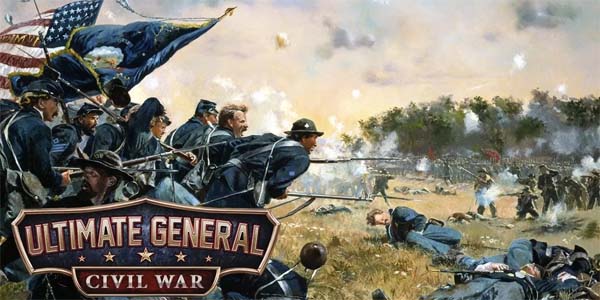

I've asked on numerous occasion for Creative Assembly to build a Total War game based on the American Civil War. I thought for sure that Total War: Shogun 2's second expansion Fall of the Samurai -- with its focus on industrialization, trains, telegraphs, gatling guns, and ironclads -- was setting the series up for a Civil War game. Sadly, that wasn't the case. Creative Assembly decided to move onto Rome II, then to Attila, before diving into all-out fantasy with -- not one, but two -- Total War: Warhammer games!
I've heard that the Total War: Warhammer games are actually pretty awesome, but I have zero interest in Warhammer, so I skipped them entirely. I'll admit that part of that was also because I was a bit bitter that I still hadn't gotten the Total War: Civil War game that I had wanted. Maybe Creative Assembly, being a studio based in the U.K. simply isn't that interested in the American Civil War? Or maybe they felt that Empire's American Revolution campaign already focused enough on the United States?
Addressing Gettysburg
But even though Creative Assembly isn't giving my that game [yet], there's no shortage of Civil War games from other developers. A few years ago, a little indie dev studio called Game Labs released one such game on Steam: Ultimate General: Gettysburg. It was a $15 budget title exclusively about the battle of Gettysburg. Not the entire Civil War, not battles surrounding or related to Gettysburg. Just Gettysburg. The game was praised for its simple UI, its historic details, and realistic, competitive, and highly-customizable A.I..
I played the game very briefly last year, but never actually finished the single battle provided, nor felt that the game was substantive enough (or that I had played enough of it) to warrant a full review. I was fairly impressed with the difficulty and challenge that the game provided, as well as the way in which it presented the actual history of the battle, while still leaving many individual tactical decisions up to the player.
If I had any complaints with that game, it probably only would have been that its narrow scope made it feel a bit overpriced at $15. I had bought it during a sale, so I didn't feel cheated, but I could easily see other people being upset by paying $15 for (basically) a tech demo of a single battle. $10 or less probably would have been the sweet spot.
Well, it turns out that Ultimate General: Gettysburg was basically a tech demo (and a financing plan) for Game Labs' larger, more ambitious project: Ultimate General: Civil War. The new game's scope encompasses the entire Civil War and includes a full campaign. It also sports a cleaner interface that clearly displays your objectives, better controls, and other improvements.
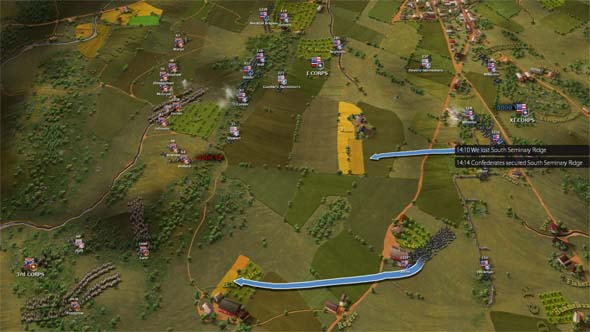
UG: Gettysburg labeled historical points of interest on the map.
When it says, "Fall back to Seminary Ridge", you know exactly where that place is.
Oddly enough, UG: Civil War isn't a strict upgrade from UG: Gettysburg. There's a few features from UG: Gettysburg that have strangely been removed. The original Gettysburg game had some very pretty battlefield artwork that displayed the names of the various locations on the map. Hills, ridges, forests, and even some individual buildings and roads were all labeled with their real-life names! McPherson's Ranch, Culp Hill, Cemetery Ridge, and more are all here. It was an excellent way of providing a sense of place to the player, as well as some historic context. Sadly that feature has been removed from the full Civil War game. I wonder if the developer just didn't have the time or resources to research that level of detail for every battle included. Or maybe it's just because the smaller skirmish sites of battles like Bull Run, Shiloh, and Antietam aren't as infamous as the sites in Gettysburg? Or maybe there were licensing issues with some of the sites, and they decided that if they couldn't include some names, then they'd rather just not include any?

The maps of UG: Gettysburg also had a stylized, polished look to them, the movement arrows were bigger and stood out more (and they stayed on screen to remind you of where the units were headed, and to give the game a textbook-like appearance), elevation and line-of-sight were a bit easier to determine, and so on. This isn't to say that UG: Civil War is a particularly ugly game to look at. If you can get past the simplistic unit sprites, then the game still looks fine. It's just that UG: Gettyburg looked noticeably better!
A House Divided Against Itself...
The campaign of Ultimate General: Civil War will take the player through most of the major battles of the American Civil War. Not just Gettysburg. It also includes some optional smaller skirmishes and situations. In between battles, you'll be tasked with spending money and character prestige to replenish your troops, recruit new and larger regiments, equip your troops with better weapons, and assigning officers to command your corps and divisions. As you win battles, you'll be awarded experience levels that you can spend to upgrade your custom general in several different categories. Upgrading your economy skill will lower the cost of troops and provisions. Increasing your organization skill will increase the size of your army. Increasing your training skill will improve the fighting ability of your regiments. And so on... [More]
de07826a-dae3-41e8-b22b-a5b0f850dc64|0|.0
Tags:Ultimate General, Civil War, Ultimate General: Civil War, Ultimate General: Gettysburg, United States, Union, Confederate States of America, Confederacy, Shiloh, Bull Run, Manassas, Gettysburg, indie gaming, Steam, history, strategy, AI, infantry, cavalry, artillery, skirmisher
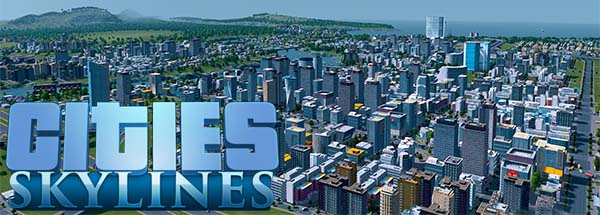
Some of the suggestions from my first wishlist have actually been implemented in Cities: Skylines. Naming roads, and adding directional traffic overlays were recently added in the Mass Transit expansion, and the previous Snowfall expansion incorporated some of my ideas for seasonal cycles (minus the part where the seasons actually cycle from one to another). There's still a lot of items from that wishlist that haven't been implemented. I also have come up with some new ideas for things I'd like to see in further expansions (or maybe a sequel?).
Taking the best ideas from its competitors
Even though Cities: Skylines is, by far, my favorite (and probably the objective best) city-building / city-simulation game of the past decade, there are still some features and ideas from the inferior games that I really like. In my first wishlist, I already talked about how much I liked the modular building mechanic of SimCity (2013).
I won't go into too much detail of why I liked that concept (even though the actual implementation was a little weak) because I invite you to read the original post. Suffice it to say, I liked the idea of certain pieces of city infrastructure (such as power plants, schools, universities, police stations, airports, government buildings, etc.) actually growing along with the city. Being able to upgrade an existing building to add additional functionality, additional capacity, or to specialize it in some way, was (in my opinion) a much more interesting and engaging process than simply plopping another copy of the same building every so often, or adjusting a global budget slider, simply to meet increasing demand.

I still think SimCity had the right idea with its modular buildings.
In that first wishlist, I also briefly mentioned the Cities XL series. There isn't much in XL (or XXL) that is done as well (or better) than what is offered in either SimCity (2013) or Cities: Skylines, but I did neglect one idea that I think was probably the most clever, interesting, and fun part of the XL series of games: the ability to "fill" an area with "decoration". Put simply, Cities XL allows the player to fill any unoccupied area of the map (that is at least partially enclosed by roads) with one of several different types of decorative landscaping.
Landscaping options include a grassy park area with trees, an open-air "flea market" with kiosks and street vendors, various plazas / courtyards, and even a makeshift construction site. These decorations aren't functionally different (the flea market doesn't produce any commerce or jobs, for example), but each decorative area applies a very small environmental beautification effect that increases happiness and land value for adjacent homes or businesses.
Decorative areas in Cities XL allows you to fill-in irregular shapes with city-beautification projects.
From a more aesthetic standpoint, Cities XL's decorative areas allow the player to make very efficient use of space, to fill any empty dead space, and to create your own custom parks and plazas that conform to whatever shapes the outlining roads happen to be. Want a park in the middle of a large roundabout? Want a plaza space at the point of a 45-degree (or narrower) intersection? XL allows you to do such things without having to go into an asset-editor to make a custom ploppable.
Despite having muuuuuch better tools for creating curved and angled roads, Skylines doesn't really have any equivalent to these decorative features from XL that allow us to fill-in gaps left by our pretty, rounded or angled roads... [More]
61f9c85f-04f1-43df-ada3-cf727a4682d8|0|.0
Tags:Cities: Skylines, Cities: Skylines: After Dark, Cities: Skylines: Snowfall, Cities: Skylines: Natural Disasters, Cities: Skylines: Mass Transit, match day, Paradox Interactive, Colossal Order Ltd., PC, SimCity, CitiesXL, CitiesXXL, city simulation, park, decoration, parking, natural wonder, national park, beach, ski resort, tourism, leisure, history
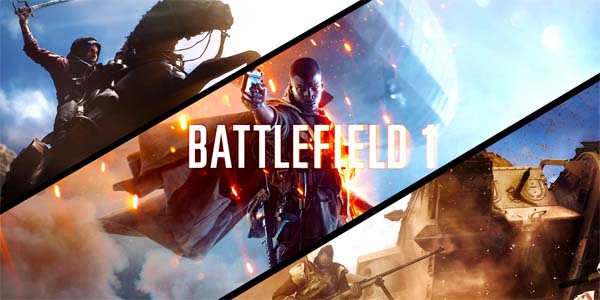
Nobody can make a game about World War I. Trench warfare is too boring. Nothing really happens. There isn't a strong, identifiable villain or good versus evil struggle.
Those are among the many excuses that people made for why all the video games are about World War II, and never about World War I. And then the gaming public and journalists got a glimpse of this:
The teaser trailer for Battlefield 1 was a smash hit.
That teaser trailer was damn good. People were excited. I haven't played a first-person shooter since Call of Duty: World at War, I generally hate online shooters, but even I was excited to try out this game! And other people were hyped about it too.
Now, I never really bought into the idea that World War I was "not video game material". I've long advocated for games to look at all periods of history for inspiration, and World War I is a monumental moment in world history that certainly deserves to be examined by games. The indie market certainly realized this, with games like Valiant Hearts and Verdun. But the big publishers have completely shied away from "The War to End All Wars".
This is a shame. The rapid technological advancements and radically new military tactics that evolved leading up to (and during) the war could be great material to examine in the form of a game. The widescale industrialization of warfare, the complicated politics, and the general fuzziness of the morality of the war are also ripe source material for dramatic storytelling. So it's about time to see this war thrust into the mass market spotlight.
I'd prefer to have seen a strategy game along the lines of Total War; but whatever, I'll give DICE and Battlefield 1 a chance.
UPDATE: 12 MARCH 2018, Better than I gave it credit for:
After having played Activision's Call of Duty: WWII and (especially) EA's Star Wars:
Battlefront II, and having talked about it with friends, I have gained a bit of respect for the successes that Battlefield 1 has been able to accomplish. I've started to like it more in retrospect. Not enough to go back and re-play it or try out any of the expansions (yet), but I do feel that I may have been a bit too harsh on the game in retrospect, especially with regard to its campaign vignettes.
I'm not going to change my original review score, but compared to CoD:WWII and Battlefront II, this game probably deserves a slightly higher grade. So keep that in mind as you read the following review. Of all the big-budget first person shooters that I've played in the past couple years, Battlefield 1
is probably the one that I most enjoyed, and it's the one that I would recommend.
The futile indifference of war
First impressions were actually pretty damned good. I was actually really impressed with Battlefield 1's campaign tutorial. It's basically a guided tour of the game's various core mechanics: shooting at enemy soldiers, capturing victory points, piloting vehicles, and so forth. It does a good job of introducing each of these mechanics and systems by jumping the player around between multiple characters in a large-scale battle.
But what really stuck out to me was how the tutorial transitioned between these different set pieces, and how it handled player death. This tutorial is actually surprisingly merciless and difficult. As you complete one set piece, the game gradually (and subtly) increases the threat until it becomes overwhelming and your character dies (or they just kill you after a timer expires), which allows the game to teleport you to the point of view of another character for the next set piece. The dying character's name and birth / death years are shown on screen during the transition, granting that character with a certain degree of humanization.
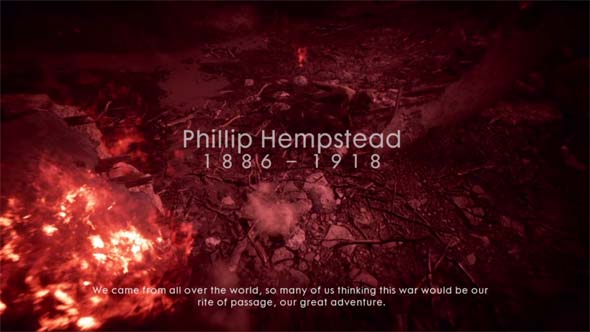
The excellent tutorial emphasizes the indifference and futility of "The War to End All Wars".
Depending on how good you are at the game, you'll go through between half a dozen to a dozen different characters, each with a name and an age. And they all die. The tutorial makes this war look brutal and futile. It even has an almost Dark Souls-like indifference to the player character, killing you without a second thought and forcing you to respawn as another poor, dumb bastard who's about to die for his country, rather than restarting you at a checkpoint until you get it right.
I even wish DICE had gone a bit further by also displaying the character's birth place and maybe even a snippet or two of other biographical trivia. Maybe listing some hobbies, or saying that he was on his high school's varsity football team, or some other little detail like that. DICE settled for just the name and birth / death year, but it's still effective and establishes a very strong running theme throughout the tutorial. The point is a bit undercut by the rapid pacing and by how conventional the actual running and shooting feels. But I still walked out of this tutorial excited by what the rest of the campaign had to offer. [More]
1b3222c5-df25-48fc-8292-199702831456|1|5.0
Tags:Battlefield 1, Battlefield, EA, Electronic Arts, DICE, PC, mouse & keyboard, EA Origin, shooter, online, multiplayer, World War I, war, history, trench warfare, chemical weapon, Harlem Hellfighters, tank, biplane, horse, England, France, Germany, Ottoman Empire, Europe, Argonne Forest, Arabia, Laurence of Arabia, eBay
|

| 12 | | | | | | | 60 | | 11 | | | | | | | 55 | | 10 | | | | | | | 50 | | 09 | | | | | | | 45 | | 08 | | | | | | | 40 | | 07 | | | | | | | 35 | | 06 | | | | | | | 30 | | 05 | | | | | | | 25 | | 04 | | | | | | | 20 | | 03 | | | | | | | 15 | | 02 | | | | | | | 10 | | 01 | | | | | | | 05 |
|